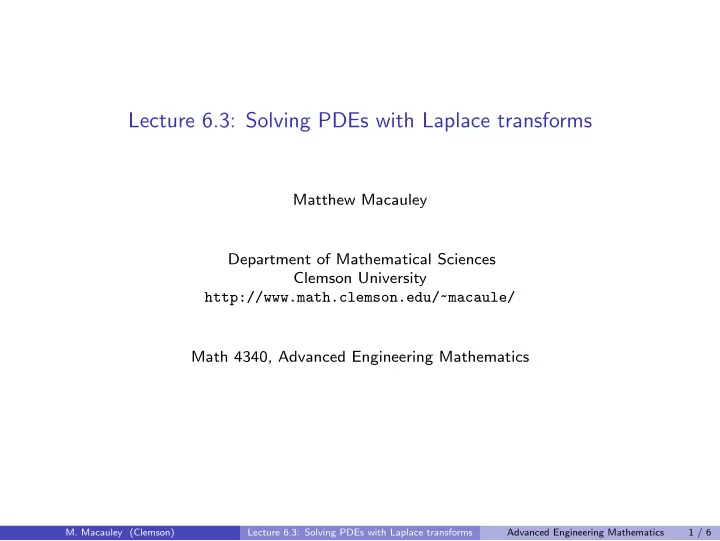

Lecture 6.3: Solving PDEs with Laplace transforms Matthew Macauley Department of Mathematical Sciences Clemson University http://www.math.clemson.edu/~macaule/ Math 4340, Advanced Engineering Mathematics M. Macauley (Clemson) Lecture 6.3: Solving PDEs with Laplace transforms Advanced Engineering Mathematics 1 / 6
Introduction A function f : [0 , ∞ ) → C has exponential order , if | f ( t ) | ≤ ce at holds for sufficiently large t , where a , c > 0. Definition Let f : [0 , ∞ ) → R be a piecewise continuous function of exponential order. The Laplace transform of f is ˆ ∞ f ( t ) e − st dt . ( L f )( s ) = F ( s ) = 0 Property time-domain frequency domain Linearity c 1 f 1 ( t ) + c 2 f 2 ( t ) c 1 F 1 ( s ) + c 2 F 2 ( s ) e − cs F ( s ) Time / phase-shift f ( t − c ) e ct f ( t ) Multiplication by exponential F ( ω − c ) 1 Dilation by c > 0 f ( ct ) c F ( s / c ) df ( t ) Differentiation sF ( s ) − f (0) dt − F ′ ( s ) Multiplication by t tf ( t ) Convolution f 1 ( t ) ∗ f 2 ( t ) F 1 ( s ) · F 2 ( s ) = ( F 1 ∗ F 2 )( s ) M. Macauley (Clemson) Lecture 6.3: Solving PDEs with Laplace transforms Advanced Engineering Mathematics 2 / 6
Laplace transforms to solve ODEs Example 1 Solve the initial value problem u ′′ + u = 0 , u ′ (0) = 1 . u ( u ) = 0 , M. Macauley (Clemson) Lecture 6.3: Solving PDEs with Laplace transforms Advanced Engineering Mathematics 3 / 6
Laplace transform of a multivariate function Definition For a function u ( x , t ) of two variables, define its Laplace transform by ˆ ∞ u ( x , t ) e st dt . ( L u )( x , s ) = U ( x , s ) = 0 pause Remark The Laplace transform turns t -derivatives into multiplication, and leaves x -derivatives unchanged: ( L u t )( x , s ) = sU ( x , s ) − u ( x , 0) ( L u x )( x , s ) = U x ( x , s ). Convolution theorem For functions f and g , L ( f ∗ g )( s ) = F ( s ) G ( s ) . By taking the inverse Fourier transform of both sides, it follows that ( f ∗ g )( t ) = L − 1 � F ( s ) G ( s ) � . M. Macauley (Clemson) Lecture 6.3: Solving PDEs with Laplace transforms Advanced Engineering Mathematics 4 / 6
Laplace transforms to solve PDEs Example 2: the diffusion equation on a semi-infinite domain Let u ( x , t ) be the concentration of a chemical dissolved in a fluid, where x > 0. Consider the following B/IVP problem for the diffusion equation: u t = u xx , u (0 , t ) = 1 , u ( x , 0) = 0 . M. Macauley (Clemson) Lecture 6.3: Solving PDEs with Laplace transforms Advanced Engineering Mathematics 5 / 6
Laplace transforms to solve PDEs Example 3: the diffusion equation on a semi-infinite domain Let u ( x , t ) be the concentration of a chemical dissolved in a fluid, where x > 0. Consder the following B/IVP problem for the diffusion equation: u t = u xx , u (0 , t ) = f ( t ) , u ( x , 0) = 0 . M. Macauley (Clemson) Lecture 6.3: Solving PDEs with Laplace transforms Advanced Engineering Mathematics 6 / 6
Recommend
More recommend